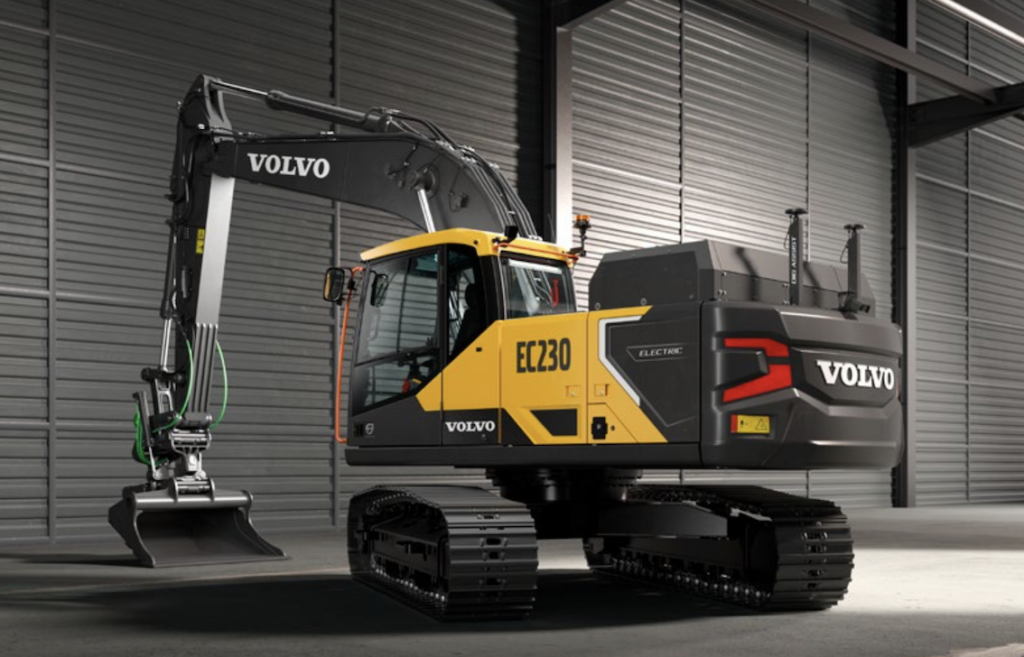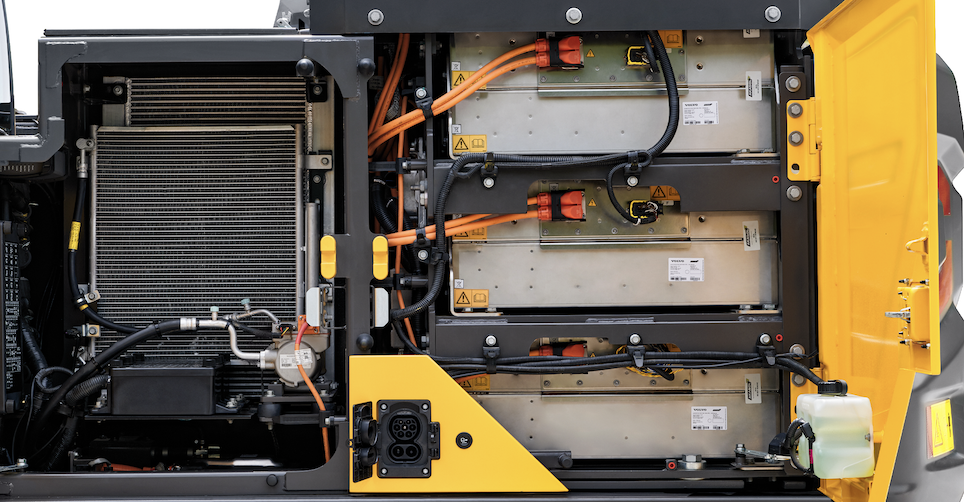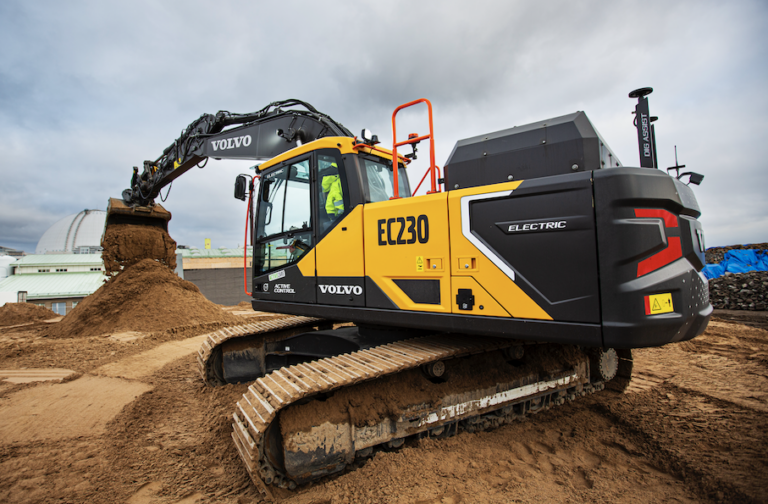The largest market-ready battery electric excavator in the world – Volvo CE’s EC230 – was first glimpsed over two years ago in China. Since then it has peeped out from under its protective covers on test sites in China, South korea and Europe. But it is only recently – at ConExpo in Las Vegas – that the full reveal took place, with the announcement that the vehicle will be available to buy in the USA from 2024. News recently came through that the machine is now available in Europe, to selected customers. We get the full lowdown on one of the OEM’s most elusive creations to date
***
As a global leader in electrification it is perhaps no surprise that Volvo Construction Equipment also has what is thought to be the largest fully commercialised battery electric excavator available anywhere. Weighing in at 23 metric tons (50,706lbs) the EC230 Electric represents a big step forward in the OEM’s commitment to sustainability.
The machine was first designed and built at the Volvo facilities in Changwon, South Korea, and originally shown to the public at Bauma China in November 2020. But this first look was not in any way a vehicle launch. Detail on the exact specifications were scant. Instead this marked the start of a process of testing with specific customers around the world.
Volvo CE took this approach to enable it to work together with partners across the supply chain, who included not only its direct customers, but also support industries such as energy suppliers. This enabled it to ensure the machine is built to match demands of different working sites around the world.
 ABOVE: Volvo CE’s EC320 ws originally shown to the public at Bauma China in November 2020
ABOVE: Volvo CE’s EC320 ws originally shown to the public at Bauma China in November 2020
Over the past couple of years, the machine has been extensively tested by customers in South Korea and China, and it has also been made available to select customers in Europe – with successful projects in Skien, Norway and Aarhus, Denmark.
“Partnering with our customers is a vital part of our innovation journey and a close cooperation with them is how we can gain valuable feedback to continually improve our offering,” says Thomas Bitter, head of technology at Volvo CE. “The EC230 Electric has proven its sustainable power and is the perfect fit for modern construction sites.”
 To read the full article including additional material and further images, visit the digital edition of iVT June
To read the full article including additional material and further images, visit the digital edition of iVT June
At ConExpo in Las Vegas in March, Volvo CE not only showcased the machine for the first time in the USA, it also announced it would be testing the EC230 in North America, firstly in a series of pilot programmes in partnership with WM, formerly known as Waste Management.
WM will be testing the machine at one of its facilities on the East Coast. The pilot will see the EC230 Electric performing waste application tasks in the same way that diesel excavators do. This will lead to several more customer tests of the excavator in various applications on the North American power grid. Following these testing programmes, Volvo CE plans to make the machine commercially available in North America in 2024. And it has just announced that the EC230 is now available to buy for selected customers in Europe.
Ahead of that, iVT gets some further insight into the design and performance of the vehicle from Lars Arnold, product manager electromobility at Volvo CE, in front of the machine on the Volvo CE stand at ConExpo.
“The EC230 Electric is based on the conventional diesel-powered EC220E, and will deliver the same performance, if not better, with the added benefits of zero emissions, low noise, and low total cost of ownership,” he says. Indeed, the EC230 is expected to achieve a 60-70% reduction of energy running costs, compared its diesel-powered equivalent.
Staying power
The EC230 Electric has been designed to work a full, 8-10 hour day, with a high-power charge during the lunch break. To do this, the machine has been equipped with four 66kW lithium-ion battery packs.
“The four battery packs provide a total of 264 kW/h,” explains Arnold. “This gives the machine enough battery capacity to run for four to five hours. If a full day’s work is needed, you can run the machine in the morning then during the lunch break, you put the machine on a 150kW DC fast charger, which will charge the machine from 0% to 80% in one hour. Then you can keep it running during the afternoon before plugging it in overnight to start afresh the next day.”
 ABOVE: The EC230 Electric is designed to work an 8-10 hour day, with a high-power charge during the lunch break
ABOVE: The EC230 Electric is designed to work an 8-10 hour day, with a high-power charge during the lunch break
In Europe the machine is provided with a CCS2 charging socket for Europe and a CSS1 socket for North America. “As soon as you plug it in, a ‘handshake’ is created and the machine starts charging,”
says Arnold. “There are two communication lines between the charger and the machine. The machine will continue to charge until you press the ‘cancel charging’ button. At this point you are able to remove the plug from the charger. As a safety feature, you cannot pull out the plug when current is going through it.”
The EC230 Electric has a 600V battery system, the same batteries deployed in Volvo’s short-haul, 150-mile range of fully electric trucks. They work optimally in temperatures between -25°C and +40°C, so an active thermal management system has been put in place.
“The batteries are water heated and cooled,” Arnold explains. “The batteries need to be cooled during DC fast charging because this generates a lot of heat. There are also two radiators – one to cool the batteries and another to cool the electric motor. We have two different systems because they have different cooling requirements.”
The EC230 Electric is equipped with a three-phase AC motor. The DC current from the lithium-ion batteries is inverted to AC in order to run the motor. “It is a synchronous, brushless AC motor, so no maintenance is needed,” says Arnold. “The motor is also water-cooled.”

ABOVE: The The four battery packs on the EC230 Electric provide a total of 264 kW/h in power
Benefits of an electric motor
The hydraulic pumps on the EC230 Electric are identical to those on the diesel model and deliver the same performance, only they are now driven by an electric motor. Accordingly, the hydraulics system works in harmony with the motor to achieve better controllability and optimised operating time.
“The electric motor makes a huge difference to the operation of the hydraulics system,” says Arnold. “This is because it gives you instant torque. With a diesel engine, you need to ramp up the RPM.”
It’s important to note that the electric motor only works when the machine is being operated, which ultimately means that there are no wasted operating hours.
“Let’s say you have filled up a bucket ready to dump into a truck, but you need to wait for a truck to arrive,” says Arnold. “The moment you stop using the joysticks, the electric motor turns off. When there is no electric motor running, no operating hours are counted. While a 1,000-hour diesel machine will spend, on average, around 300 hours just sitting there and not generating any profit for customers, a 1,000-hour EV will work for 1,000 hours. Fewer operating hours can help reduce your total cost of ownership and improve resale value.”
Another big benefit of the electric model is that all costs related to diesel engine maintenance are eliminated. There is no need to change the oil in the filter and there is no after treatment system. This means that maintenance costs are much lower.
“Performance wise, it’s the same as a diesel machine, but it feels much better,” says Arnold. “There is increased comfort for the operator because there is no noise, no vibrations from the engine, and no exhaust gases. There is also no need to fill the machine with diesel. It creates
a comfortable operating environment. And comfortable operators are productive operators.”
An electric future?
Arnold is keen to point out that the EC230 Electric hasn’t been designed to replace diesel machines in all applications. “It’s an additional offering,” he says. “It’s inevitable that we are going to move away from internal combustion engines, but they will need to stick around for a while because there will be some applications where electric and hydrogen vehicles will not work, such as in remote areas. So, this machine is for customers who have an actual need for an EV, due to sustainability targets, or they could be working indoors, or underground in tunnels. They might even have subsidies available.”
Despite the current logistical challenges with access to power, electric-powered equipment has the potential to make a huge difference to the green credentials of the construction sector. “There will be
a lot more to come over the next few years,” says Arnold. “We are already seeing this in automotive sector. In some countries, registrations for fully electric cars are already going up. For the construction sector, it’s only
a matter of time.”





